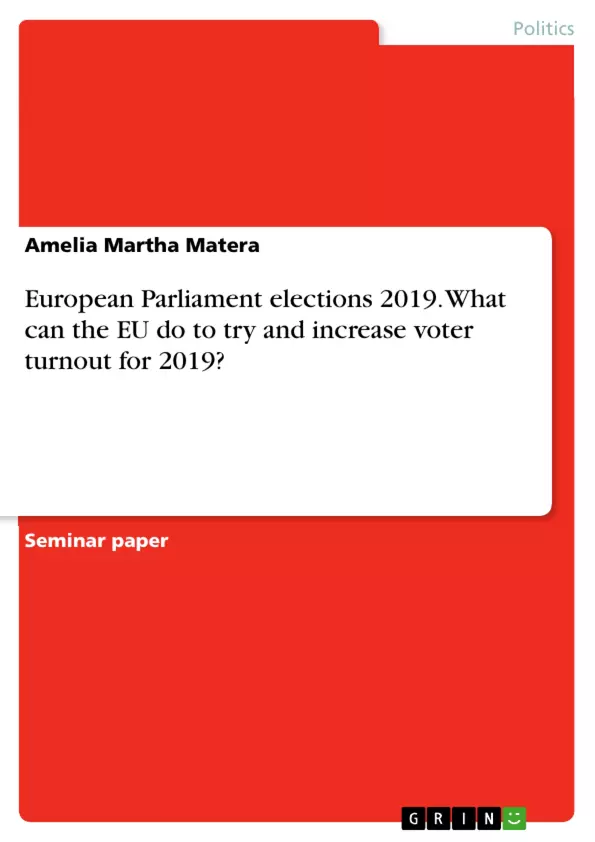It is becoming increasingly difficult to ignore the low voter turnout at the European Parliament (EP) and its future elections are just around the corner, 2019. The purpose of this paper is to review past EP elections and define proposals, which could allow the European Union (EU) to fight abstention, and to give an opinion about the voter turnout at the next elections.
The first section of this paper will examine the role and development of the EP, discuss the EU democratic deficit and Euroscepticism. It is fundamental to have a background in this field before coming to an analysis of the past elections, parties and Members of the EP (MEP) and to the main discussion of this paper, the proposals the EU could adopt to increase voter turnout and to a personal opinion of future voter turnout.
The EP is the only directly elected international Parliament, this institution has many peculiarities. (Wagner, 2002:24) At the beginning of the EU, the EP was merely an assembly with a consultative role, it was with the Rome Treaty that the first view of a Parliament came out which was finally established in 1979. (Wagner, 2002: 24) The steps of its empowerment are several, the most important are: in 1987 the Single European Act which introduces the co-operation procedure, 1993 the Maastricht Treaty, which introduces the co-decision procedure and the Amsterdam Treaty in 1999 which extend the co-decision procedure. (Wagner, 2002: 25) The last and more important step of empowerment is with the Lisbon Treaty, which set out the co-decision as the normal legislative procedure.
Inhaltsverzeichnis (Table of Contents)
- Introduction
- EP, Democratic deficit and Euroscepticism
- Past election
- Party and electoral system
- Low turnout
- Future Election 2019 - Factors for a low voter turnout
- Suggestions: What can the EU do?
- Conclusions
Zielsetzung und Themenschwerpunkte (Objectives and Key Themes)
This paper explores the decline in voter turnout for European Parliament elections and examines potential measures the European Union could take to increase voter participation in the upcoming 2019 election. The primary objective is to analyze past elections, identify factors contributing to low voter turnout, and propose solutions for a more engaged electorate.
- The role and development of the European Parliament
- The concept of the EU's democratic deficit and Euroscepticism
- Factors influencing voter turnout in past European Parliament elections
- Potential EU initiatives to address low voter turnout
- A personal opinion on future voter turnout
Zusammenfassung der Kapitel (Chapter Summaries)
- Introduction: This section sets the stage by highlighting the significance of low voter turnout in European Parliament elections and outlines the paper's objectives. It also provides a brief overview of the structure and key topics covered throughout the paper.
- EP, Democratic deficit and Euroscepticism: This chapter delves into the evolution of the European Parliament as a directly elected institution, examines the concept of the EU's democratic deficit, and explores the rise of Euroscepticism, its origins, and its influence on political parties.
- Past election: This section analyzes voting patterns in previous European Parliament elections. It explores the "second-order" theory of voting behavior, examines the impact of party systems and electoral systems on voter turnout, and discusses the challenges of low turnout and its implications for the democratic legitimacy of the European Parliament.
Schlüsselwörter (Keywords)
Key terms and concepts explored in this paper include European Parliament, voter turnout, democratic deficit, Euroscepticism, electoral systems, political parties, and EU policy initiatives. The focus is on understanding the factors contributing to low voter turnout in European Parliament elections and exploring potential solutions to enhance citizen engagement in the democratic process.
- Arbeit zitieren
- Amelia Martha Matera (Autor:in), 2018, European Parliament elections 2019. What can the EU do to try and increase voter turnout for 2019?, München, GRIN Verlag, https://www.grin.com/document/442599



